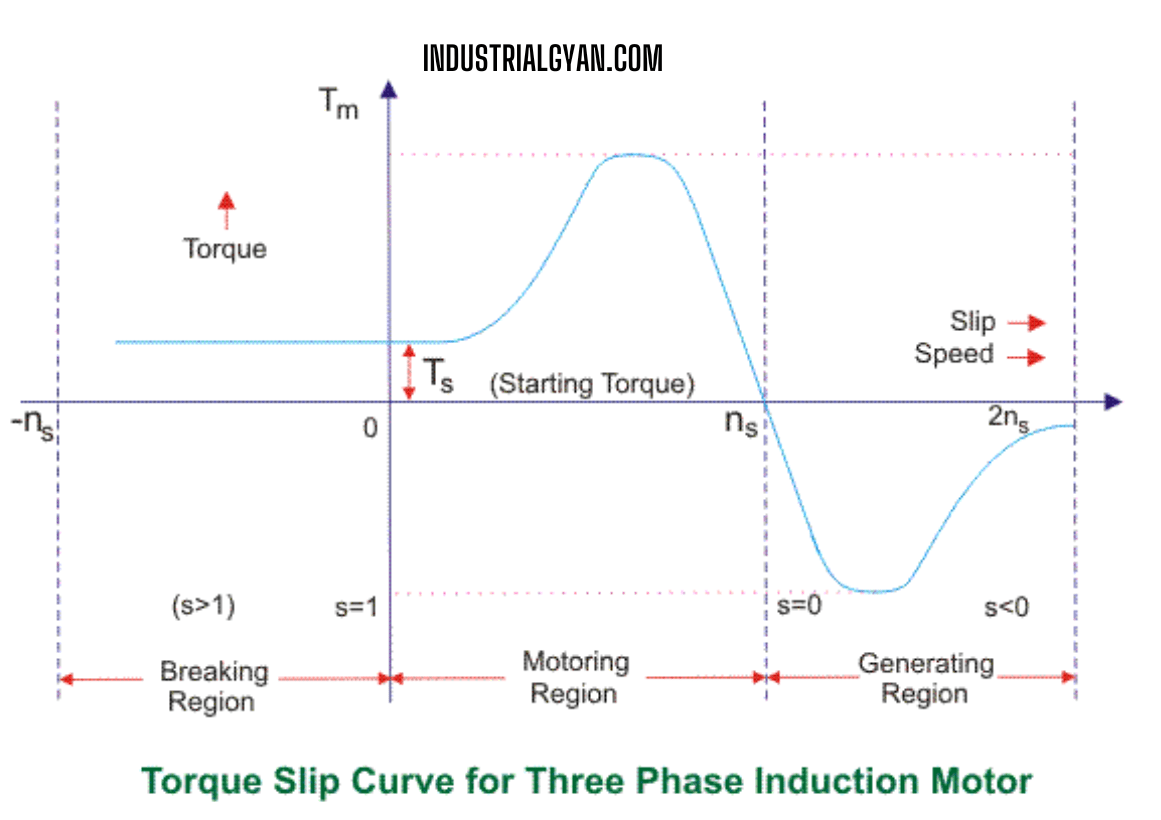Torque Slip Characteristics of Induction Motor curve is a relation between the torque & slip of an induction motor. it gives the relative information of torque with respect to slip.
Slip of Induction Machine:-
Generally, Slip is defined as the Synchronous Speed and actual speed of an induction machine. the changes in slip can be obtained by changing the speed of the motor. while variation in slip can affect the speed of the machine & respectively the variation can be obtained in torque.
Slip Calculation formula
Slip = (Ns-Nr)/Ns
Where- Ns- Synchronous speed
Nr- Rotor Speed(Actual Speed)
The standard formula of Torque slip.
Torque Slip Characteristics of Induction Motor:-

You can divide the Torque Slip Characteristics curve into three regions.:-
- The Linear Region: Torque and slip show a linear relationship, with the motor running at a low slip rate.
- The Non-Linear Region: Torque and slip exhibit a non-linear connection, and the motor operate at a moderate slip rate.
- The Saturation Region: Torque remains constant, regardless of the slip rate, and the motor runs at a high slip rate.
Motoring Mode:-
The motoring mode of an induction motor involves the conversion of electrical energy into mechanical energy. In this mode, the stator windings produce a rotating magnetic field that interacts with the rotor windings, thereby inducing an electromotive force. As a result, a current flows in the rotor,
generating a magnetic field that opposes the stator field. This interaction leads to the generation of a torque that rotates the rotor and drives the mechanical load.
Additionally, the high active power input and low reactive power input in this mode ensure maximum efficiency and minimum power loss, making the induction motor a reliable and efficient option for driving mechanical loads.
Generating Mode:-
In the generating mode of induction motors, mechanical energy becomes electrical energy. The rotor rotates from an external source, such as a prime mover, inducing an EMF in the rotor windings. This causes a current flow in the rotor, creating a magnetic field that interacts with the stator field. This interaction generates electrical power output.
The generating mode boasts high active power output and low reactive power output for maximum efficiency and minimum power loss. It makes induction motors a useful tool for generating electrical power.
Breaking Mode:-
In the breaking mode of an induction motor, the mechanical energy is converted into electrical energy as the motor acts as a generator. This results in the slowing down of the rotor and the conversion of its kinetic energy into electrical energy, which is then dissipated as heat.
The breaking mode is useful for controlling the motor’s speed or quickly stopping it. The high active power input and low reactive power input result in maximum efficiency and minimum power loss, making the induction motor a versatile device for controlling mechanical loads.

I am an electrical & automation engineer with extensive experience in Design, PLC programming, SCADA development, and IoT integration. I have a strong background in the industry, focusing on the Design & Development of Hardware, Software &Industry 4.0 technologies, and the integration of intelligent manufacturing systems.
I have a deep understanding of electrical principles and am proficient in various programming languages, including Ladder Logic, Structured Text, and Python. In addition, I have experience with various PLC, SCADA & IoT technologies and a track record of successful integration projects for various clients.


